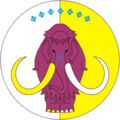Top Qs
Timeline
Chat
Perspective
Ust-Yansky District
District in Sakha Republic, Russia From Wikipedia, the free encyclopedia
Remove ads
Ust-Yansky District (Russian: Усть-Я́нский улу́с; Yakut: Усуйаана улууһа, romanized: Usuyâna ulûha, Yakut pronunciation: [usujaːna uluːha]) is an administrative[1] and municipal[6] district (raion, or ulus), one of the thirty-four in the Sakha Republic, Russia. It is located in the north of the republic in the Yana River delta on the coast of the Laptev Sea and borders with Allaikhovsky and Abyysky Districts in the east, Momsky District in the south, Verkhoyansky District in the southwest, and with Bulunsky District in the west. The area of the district is 120,300 square kilometers (46,400 sq mi).[3] Its administrative center is the urban locality (a settlement) of Deputatsky.[3] Population: 6,810 (2021 Census);[9] 8,056 (2010 Census);[4] 10,009 (2002 Census);[10] 41,265 (1989 Soviet census).[11] The population of Deputatsky accounts for 37.0% of the district's total population.[4]
Remove ads
Geography
The main rivers in the district include the Yana, the Omoloy with the Ulakhan-Kyuegyulyur, the Sellyakh, as well as the Chondon with its tributary the Nuchcha. The Kyundyulyun, northernmost spur of the Chersky Range, rises north of Ust-Kuyga. There are numerous lakes in the district. Orotko is one of the largest.[12][13][14]
Average January temperature ranges from −32 to −40 °C (−26 to −40 °F) and average July temperature ranges from +4 to +12 °C (39 to 54 °F).[2] Annual precipitation ranges from 150–200 millimeters (5.9–7.9 in) in the north to 250–300 millimeters (9.8–11.8 in) in the south.[2]
Remove ads
History
The district was established on January 5, 1967.[2]
Demographics
As of the 1989 Census, the district had a population of 41,265 inhabitants, with an ethnic composition as follows:[2]
However, a great deal of the ethnic Russian population left with the economic downturn following the collapse of the Soviet Union, so much so that the district lost over three-quarters of its population during the 1990s.
In the 2021 census, the indigenous Yakuts again formed a plurality (around a half) of the inhabitants, with the total population now just 6,810. In that year, the ethnic composition of the district was:[15]
- Yakuts: 48.5%
- Russians: 20.7%
- Evens: 20.2%
- Yukaghirs: 2.8%
- Ukrainians: 2.7%
- other ethnicities: 5.1%
Economy
The main industries are gold mining, reindeer herding, fishing, and fur trade. There are deposits of gold, tin, tungsten, mercury, lead, zinc, and brown coal.[2]
Inhabited localities
Divisional source:[16]
Population source:[4]
*Administrative centers are shown in bold
Remove ads
References
External links
Wikiwand - on
Seamless Wikipedia browsing. On steroids.
Remove ads




